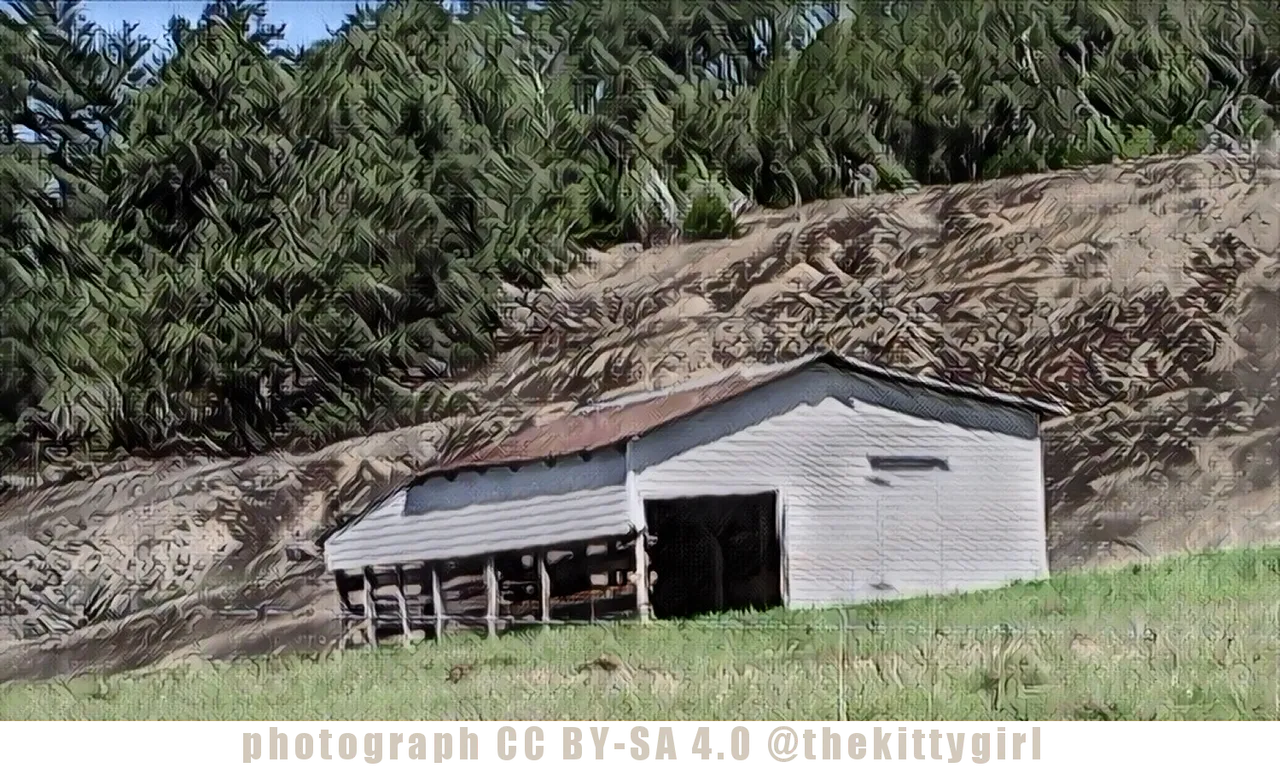This is one of several barns on an actual working farm along Highway 183 in Pickens County, South Carolina (US). The barn is in an unusual place, situated at the very edge of a large granite outcrop at the base of a small mountain. That rock outcrop is easily seen behind the barn in the photo, below.

This is only one barn among several barns and outbuildings on the property, but this is the only one that can be clearly seen from the roadside. This 83-acre (34 hectare) homestead is remarkable in that it was built in the 1800s and is listed in the National Register of Historic Places (NRHP).
The main house on the property was built in 1895 and embodies Folk Victorian architecture, which makes the dwelling lovely, in itself. The entire homestead, moreover, serves as a perfect example of a typical local farm of the 1800s and early 1900s, and was added to the NRHP because of this.
The original farmer (Mr. Williams), as well as the one to whom he later sold the property (Mr. Ligon), employed careful thought in the management of the farm and its resources. Guidance was obtained from the Clemson University Extension Service as well as the United States Soil Conservation Service, which earned awards two different years. A third generation of the Ligon family is currently working the property.
This barn pictured above is described as Hay Barn (ca. 1965):
The barn is covered in white synthetic siding and features an uneven pitched tin roof. There is a door and a large opening on the west side, while the east side extends beyond the expanse of the roof. The north side is supported by timber halfway up, where it becomes the same material as the rest of the structure. [source]
Further descriptions of buildings on the property list many other structures in addition to the barn described above. Besides the main house that was built in 1895, there was an original "old house" built in 1875 that was converted into a barn sometime after 1895; that barn is still standing and in-service. Other significant buildings on the property include: 1895 smokehouse, 1930 wood shed, 1930 privy, 1935 chicken coop, 1950 well house, 1950 chicken brooding house, 1950 chicken house/barn, 1940 garage, 1955 barn, 1955 milking house, 1960 barn, 1990 utility building, and a 1995 well house. Only some of those structures were relevant to the listing of the homestead as a place of importance on the National Register of Historic Places.

screenshot from BING Maps
The further one travels from the center line of a mountain range, the smaller the mountains become, breaking into even smaller mountains in the area called the piedmont ("foot of the mountains"). At the edges of the region where the mountains give way to rolling hills, there are often diminutive mountains that stand alone, only rising slightly above the surrounding terrain. Such is the case with Cedar Rock Mountain, which only has an elevation of 1398 feet (426 meters) above sea-level.

For those who want to see the original photo of OLD BARN № 077, here it is, below. I think the granite outcropping behind the barn is lovely and very impressive! I marvel at it every time I drive past!

For anyone who is interested-enough in old homesteads or history, you can read more about this property in the sources I have listed below. The first of those sources also has a link to the nomination form for the property with the National Register of Historic Places, which I found to be a quite interesting thing to read.
 😊
😊SOURCES
1 South Carolina Department of Archives and History
2 Wikipedia: National Register of Historic Places
3 Wikipedia: Williams–Ligon House






to learn more about either of these projects, please visit: @heyhaveyamet or @theterminal

31-Jul-2020
